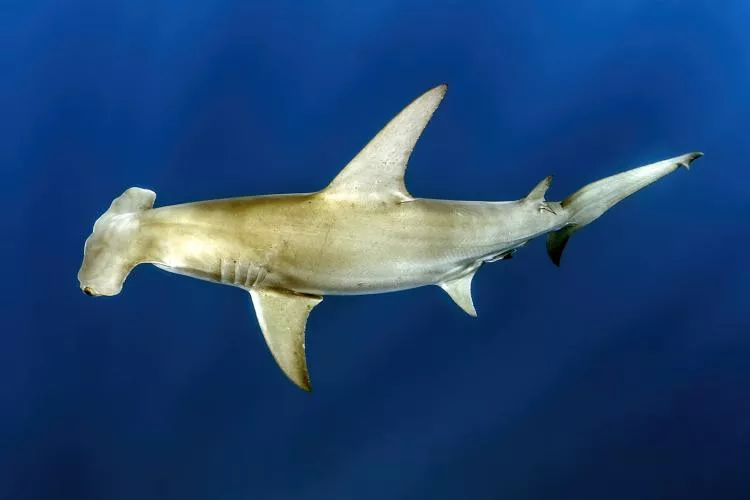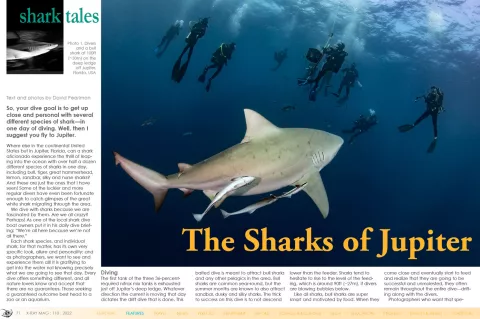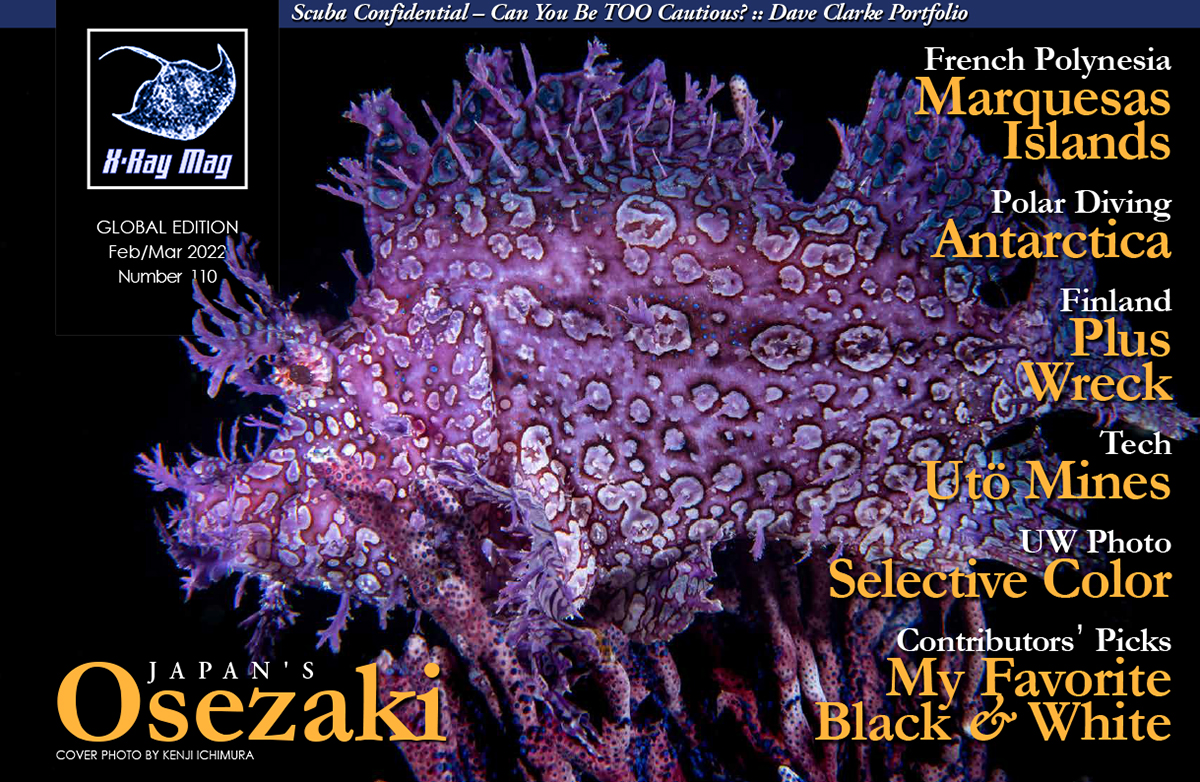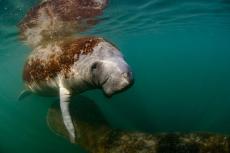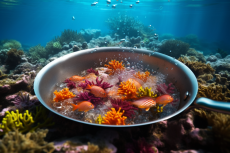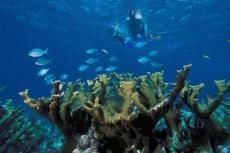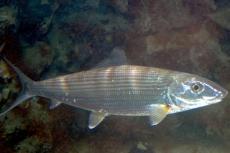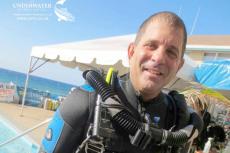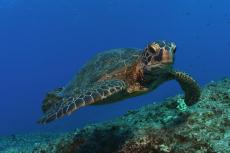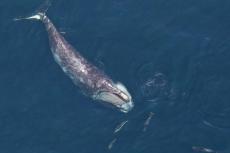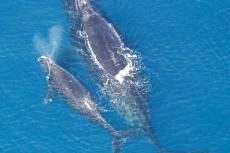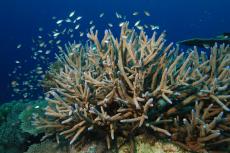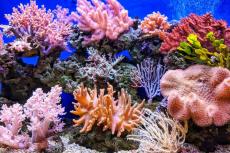So, your dive goal is to get up close and personal with several different species of shark—in one day of diving. Well, then I suggest you fly to Jupiter.
Where else in the continental United States but in Jupiter, Florida, can a shark aficionado experience the thrill of leaping into the ocean with over half a dozen different species of sharks in one day, including bull, tiger, great hammerhead, lemon, sandbar, silky and nurse sharks? And these are just the ones that I have seen! Some of the luckier and more regular divers have even been fortunate enough to catch glimpses of the great white shark migrating through the area.
We dive with sharks because we are fascinated by them. Are we all crazy? Perhaps! As one of the local shark dive boat owners put it in his daily dive briefing: “We’re all here because we’re not all there.”
Each shark species, and individual shark, for that matter, has its own very specific look, allure and personality; and as photographers, we want to see and experience them all! It is gratifying to get into the water not knowing precisely what we are going to see that day. Every dive offers something different, and all nature lovers know and accept that there are no guarantees. Those seeking a guaranteed outcome best head to a zoo or an aquarium.
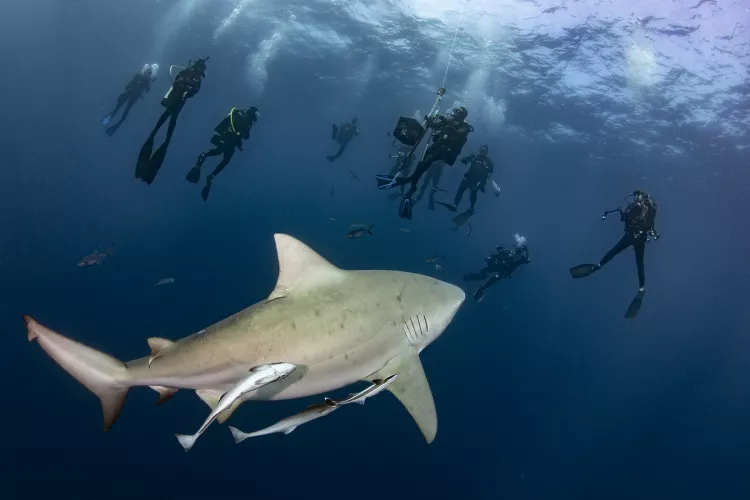
Diving
The first tank of the three 36-percent-required nitrox mix tanks is exhausted just off Jupiter’s deep ledge. Whatever direction the current is moving that day dictates the drift dive that is done. This baited dive is meant to attract bull sharks and any other pelagics in the area. Bull sharks are common year-round, but the summer months are known to also attract sandbar, dusky and silky sharks. The trick to success on this dive is to not descend lower than the feeder. Sharks tend to hesitate to rise to the level of the feeding, which is around 90ft (~27m), if divers are blowing bubbles below.
Like all sharks, bull sharks are super smart and motivated by food. When they come close and eventually start to feed and realize that they are going to be successful and unmolested, they often remain throughout the entire dive—drifting along with the divers.
Photographers who want that specific image with nothing but open water behind the shark will hover farthest away from the feeder. Those who want to get more toothy shots can place themselves relatively close to the feeder. After 20 minutes or so, the feeder will slowly ascend to shallower depths. Most of the time, the bull sharks will follow the divers, giving underwater photographers a chance to capture the godlight streaming down behind them.
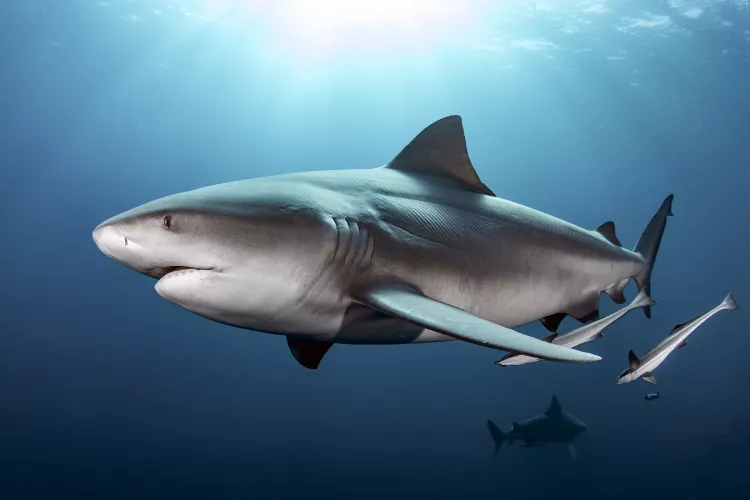
The second and third dives are shallower and, from my experience, yield more compelling images than the drift dive. These dives cover one to two wrecks, just over the three-mile maritime line, in about 70ft (~20m) of water. Here, one can legally participate in shark-feeding activities off the Florida coast.
It is exciting to arrive at a wreck, get in the safety formation (kneeling on the wreck and looking unappetizing in dark dive gear), and watch the lemon sharks feed. These enthusiastic, puppy-like sharks are almost always there and ready to share a bite to eat. I really do enjoy these lemon sharks because they are endlessly cute and entertaining.
One female named Snooty has a physical trait that I have not seen in any other shark. At first, I thought it must have been a wound caused by a fisher or other reckless act, but I have since learned that she has a birth defect. She is cheeky in both looks and personality. It is almost as though she knows that she is terrifyingly gorgeous, and she wants you to know it too.
Now, if a tiger shark turns up, it immediately becomes the star of the show, and the lemon sharks become little more than obstacles that occasionally get in the way of a clear shot of the tiger shark. This dynamic goes on for the entire dive, unless it is a really lucky dive, and a great hammerhead shark emerges from out of the blue. At this point, the hammerhead naturally becomes the star! But great hammerheads are far more skittish, and it is quite rare that they get close enough to feed and pose for a brilliant shot. This explains my almost complete lack of good images of a great hammerhead shark in Jupiter.
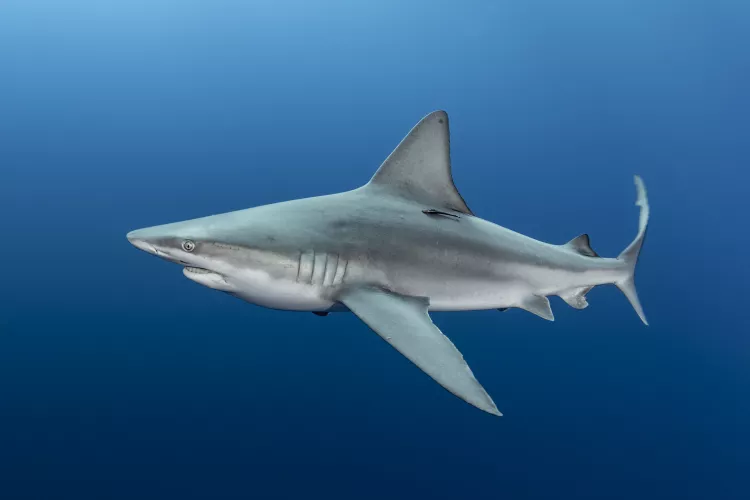
Recognizing individuals
For me, the best days are when the tiger sharks show up, as they dazzle me with their breathtaking size and striped beauty. I have learned that they have been maligned as aggressive man-eaters, while they are actually quite capable of distinguishing between humans and their food.
I have come to know and admire a few different tiger shark individuals in Jupiter. Two females, Djenny and Sophia, and one male, Patrick, often migrate through the area during the spring and summer months.
Occasionally, particularly when the same wreck is visited on two consecutive dives, one of these three tiger sharks is already there and will greet divers on the descent—escorting them to the wreck. That is one of the best times to get a stellar shot of a tiger shark in open water.
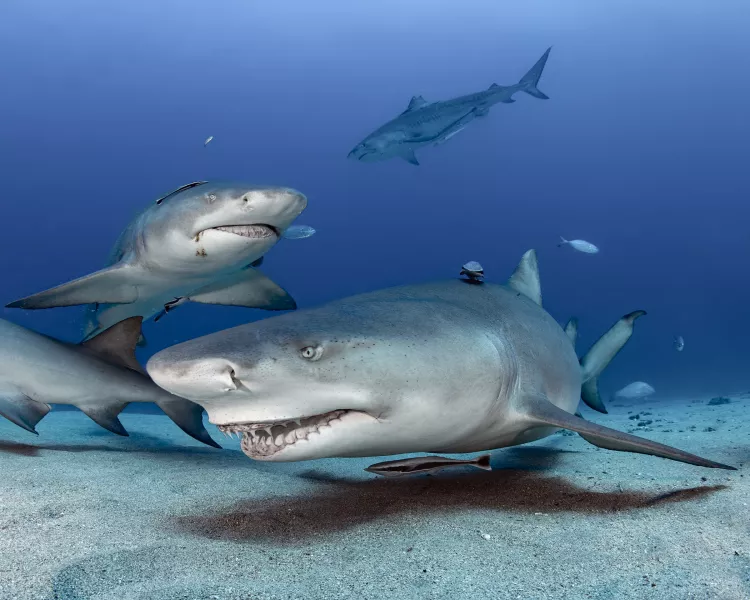
Shark-feeding controversy
Before I discuss some of my favorite shark images, I want to comment briefly on the controversial practice of shark feeding. Opponents of the practice claim that sharks are being conditioned to associate people with the smell of food, which they believe is dangerous for humans and detrimental to sharks.
Admittedly, as a professional photographer who is eager to capture compelling images of sharks, I fully recognize and admit to my own personal bias. Unfortunately, it is impractical to expect sharks to spend much time around divers without the incentive of food. Effectively everything that has been gained in the study of, and broader appreciation for, sharks has been made possible through the practice of shark feeding. However, I write this with an open mind as well as a strong understanding and respect for both sides of the issue.
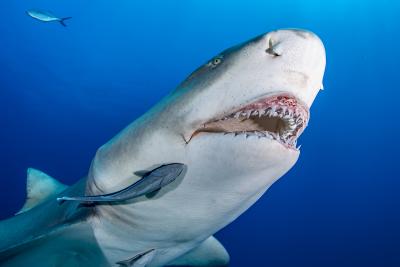
Photographing sharks
Divers descend to approximately 100ft (~30m) over Jupiter’s deep ledge (see Photo 1). It is crucial that the divers stay behind and at the same depth as the feeder, and that everyone glides along together in the same direction. It usually does not take very long to attract the bull sharks, which always seem to enjoy a free handout.
Your best opportunity to capture a shark portrait without any divers in the image is to hover away from the feeder towards the outskirts of the group. (See Photo 2.)
In the summer months, when divers are out over the Jupiter ledge, trying to incentivize the bull sharks to join them, you can occasionally come upon sandbar sharks (see Photo 3). From a distance, one could swear a bull shark was coming. Once they get close enough, however, their oversized dorsal fin and pointier snouts make it obvious that you can cross the sandbar shark off your bucket list.
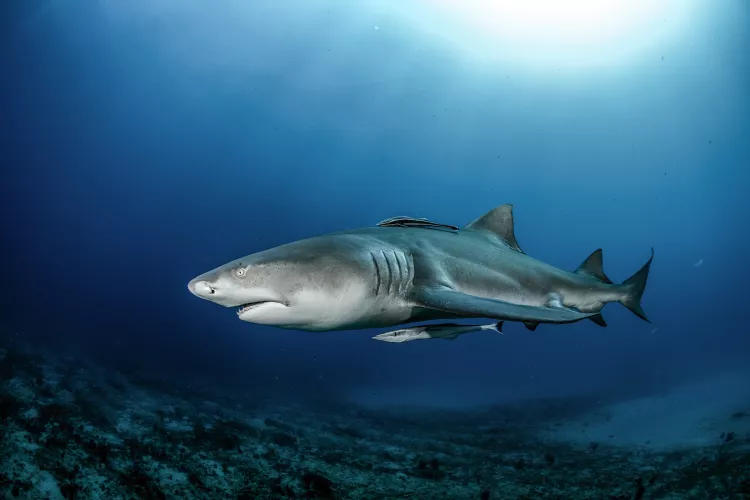
Lemon sharks are like hungry puppy dogs. The minute they smell the bait bin, they are all over the place. There is a “no-touch” policy with these sharks because while they do not pose much of a threat to divers, there is the possibility of them confusing a waving hand for bait. The trick is to relax and keep your extremities close to your body. In Photo 4, Snooty and another lemon shark check me out, with the tiger shark Sophia in the background.
A close-up of Snooty shows her mouth deformity (see Photo 5). I like to think she is keenly aware of her almost cartoon-shark-like appearance and uses it to her advantage. She is, without question, a local favorite.
After about a half-hour on the wrecks, divers drift along with the current, taking along whatever bait is left in the bins (see Photo 6). As long as the scent holds out, the sharks will follow. This provides another opportunity to get a beautiful shark portrait with great backgrounds of open water.
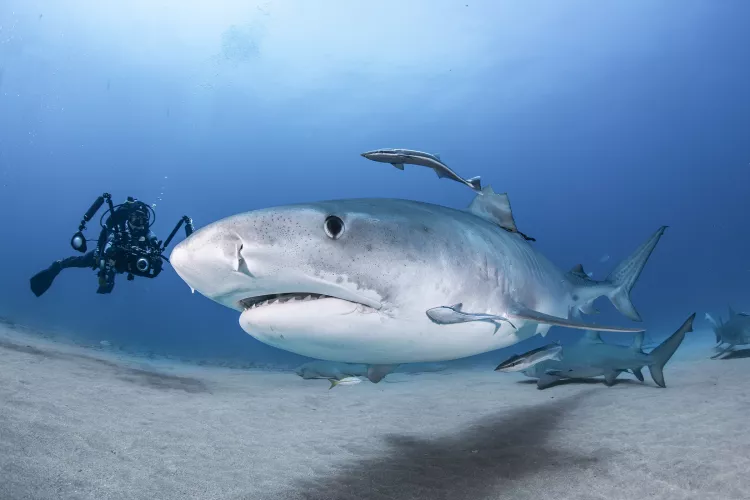
Sophia and the paparazzi (see Photo 7): She is one of two female tigers that come for a visit every so often. She is easy to identify, due to the unusual notch in her dorsal fin.
Time for your close-up, Patrick (see Photo 8). Of the three tiger sharks that visit divers in Jupiter, Patrick is the most striking. He is probably the youngest, as his tiger stripes are still dark and quite clear. As tigers get older and larger, their stripes tend to fade somewhat.
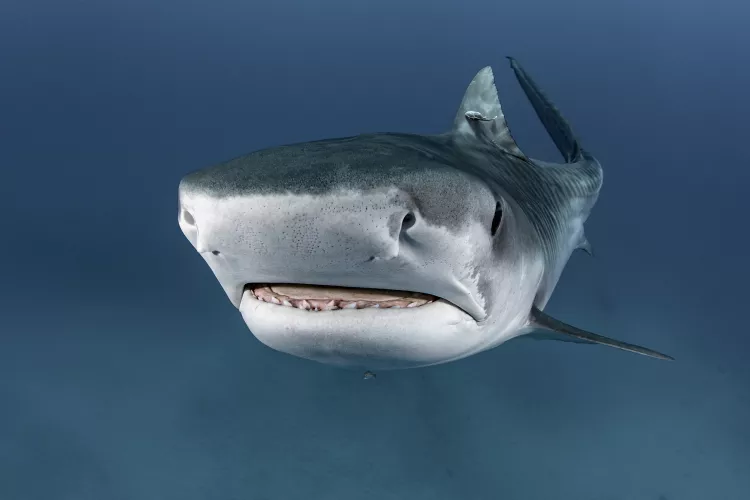
Djenny is one of my absolute favorite tiger sharks (see Photo 9). When she shows up to a dive, the water turns electric. Like any of the local tiger sharks, Djenny is not shy. She seems quite comfortable swimming right up to the divers for a game of chicken—a game we are all too happy to let her win. It is only when tiger sharks get too close that a diver should gently but firmly put a hand on the top of its snout and confidently guide it in another direction.
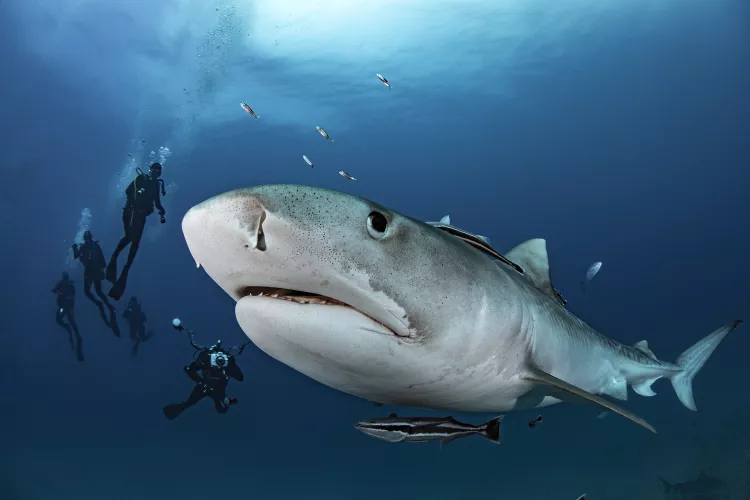
The crème de la crème, the great hammerhead sharks, add a totally different dynamic to a shark dive—even more so than a tiger shark. All eyes become instantly glued to these amazing-looking creatures, with their strange head shape and unusually tall dorsal fins, when they come close to investigate the scene.
They maneuver their way around the outskirts of the feeding, circling and circling. I have been told that if they feel comfortable enough to feed, they will hang around and get as close as any of the other sharks. But I personally have never been so lucky as to see that happen! This big boy (Photo 10) followed me from mid-water back to the boat.
I hope that you enjoy these images and come to love these majestic creatures as I have.

